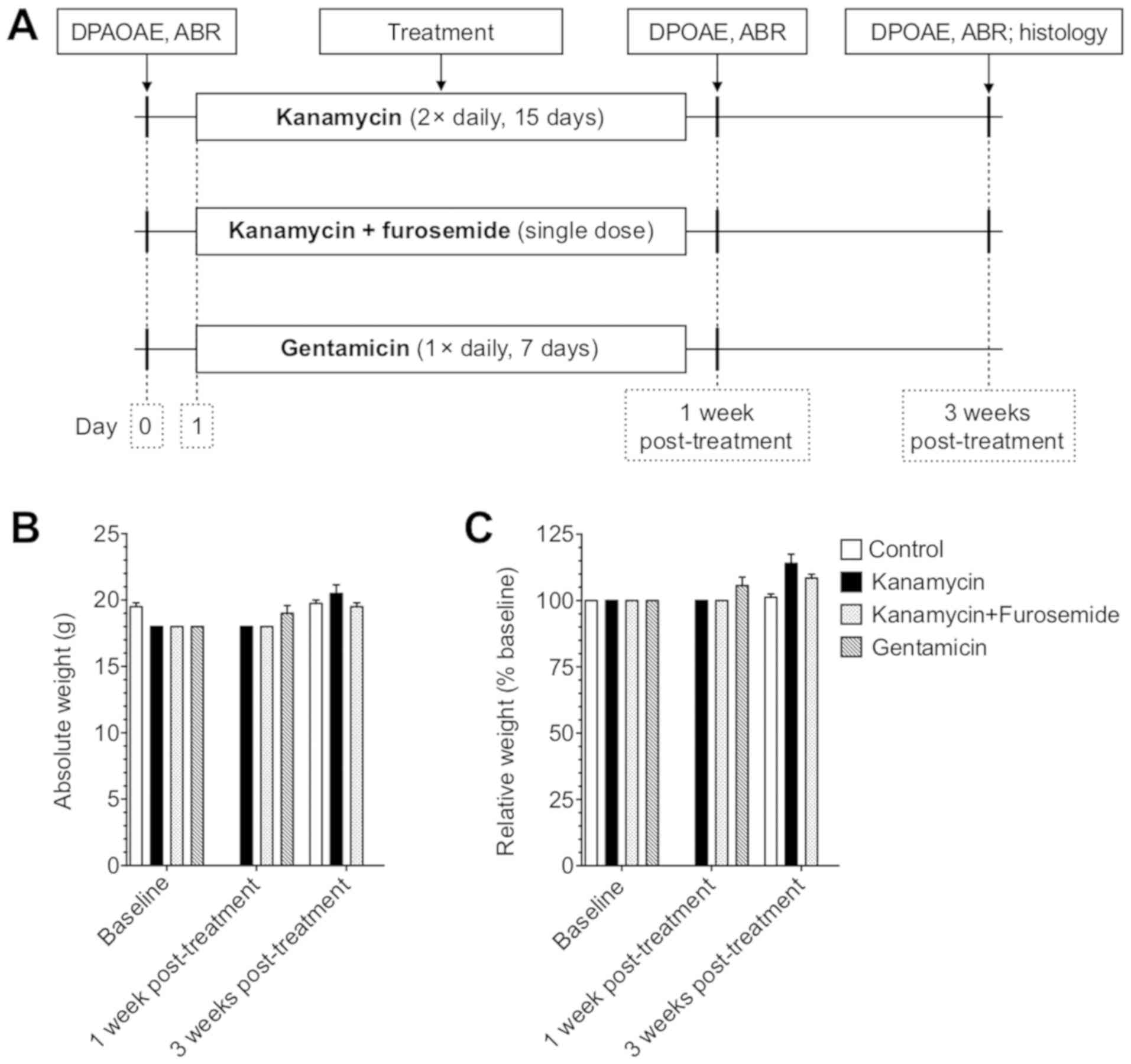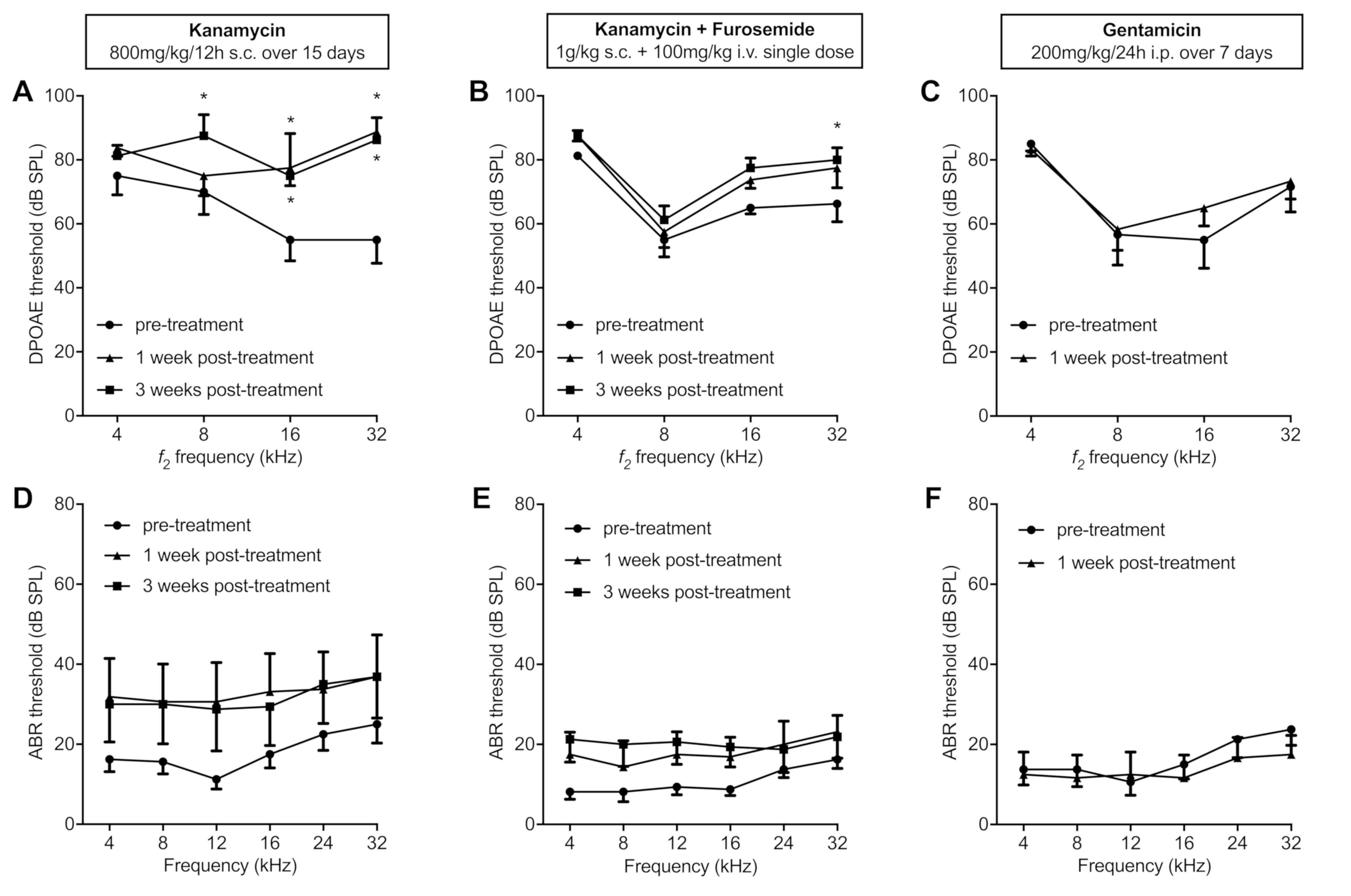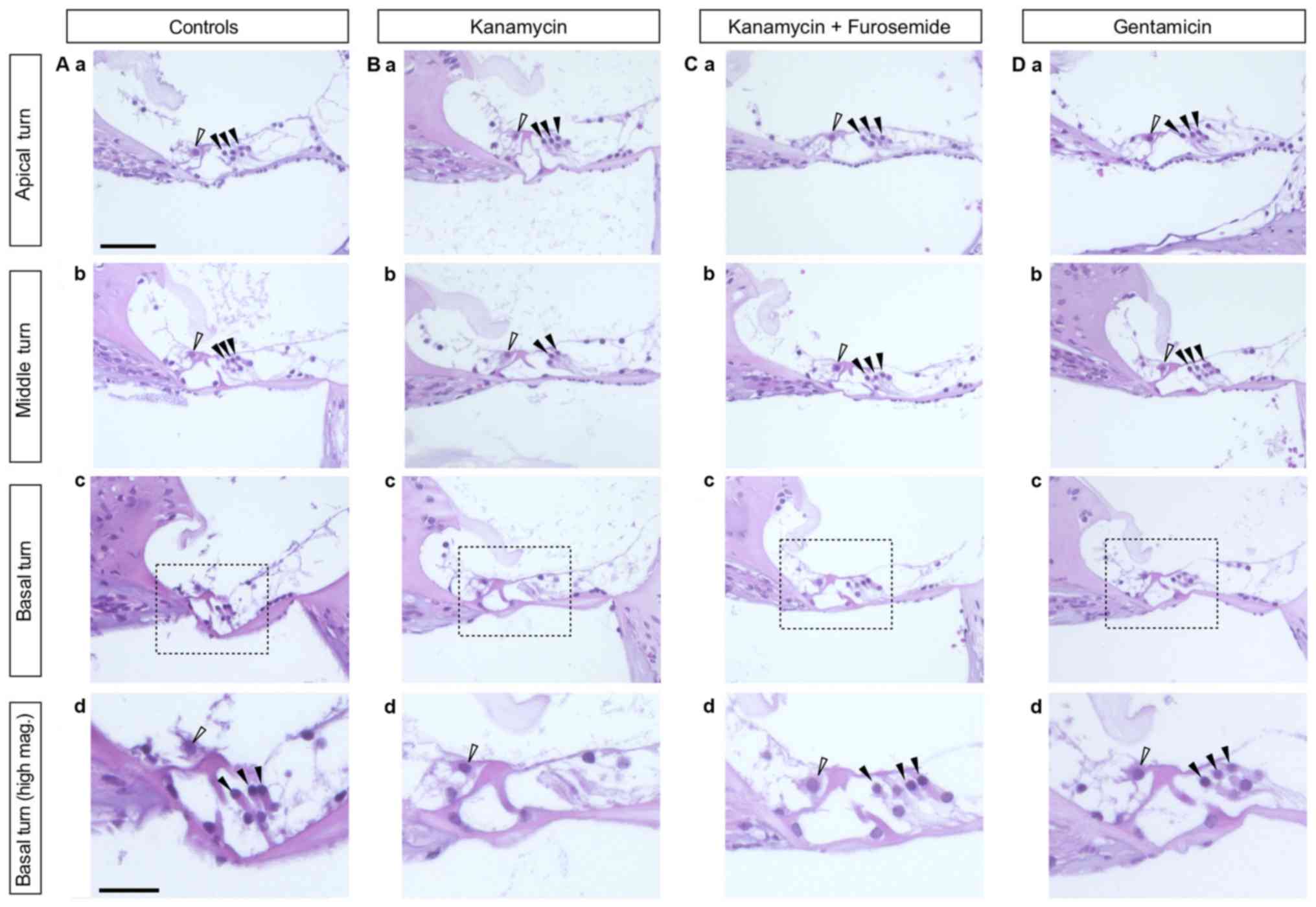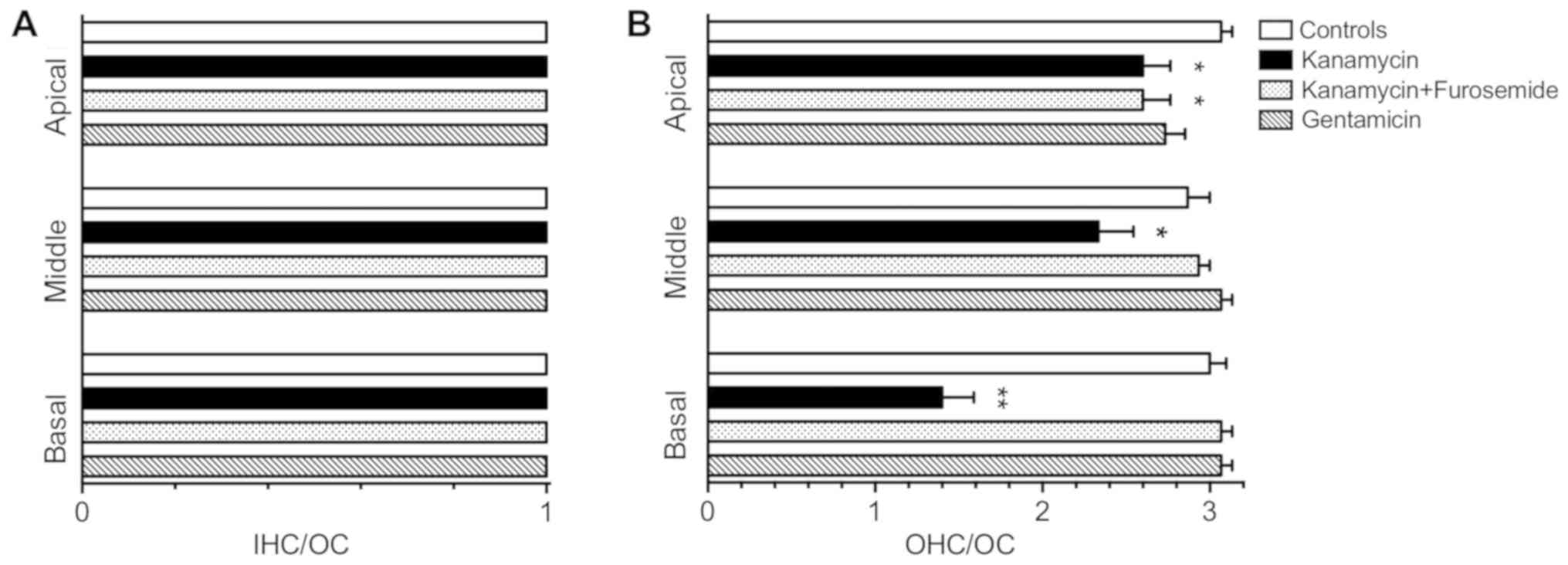|
1
|
World Health Organization, Geneva. WHO
Fact sheet 2018. Deafness and hearing loss, . http://www.who.int/mediacentre/factsheets/fs300/en/March
20–2019
|
|
2
|
Brummett RE and Morrison RB: The incidence
of aminoglycoside antibiotic-induced hearing loss. Arch Otolaryngol
Head Neck Surg. 116:406–410. 1990. View Article : Google Scholar : PubMed/NCBI
|
|
3
|
Blakley BW, Hochman J, Wellman M, Gooi A
and Hussain AE: Differences in ototoxicity across species. J
otolaryngol Head Neck Surg. 37:700–703. 2008.PubMed/NCBI
|
|
4
|
Guthrie OW: Aminoglycoside induced
ototoxicity. Toxicology. 249:91–96. 2008. View Article : Google Scholar : PubMed/NCBI
|
|
5
|
Murillo-Cuesta S, Contreras J, Cediel R
and Varela-Nieto I: Comparison of different aminoglycoside
antibiotic treatments to refine ototoxicity studies in adult mice.
Lab Anim. 44:124–131. 2009. View Article : Google Scholar : PubMed/NCBI
|
|
6
|
Corrado AP, de Morais IP and Prado WA:
Aminoglycoside antibiotics as a tool for the study of the
biological role of calcium ions. Historical overview. Acta Physiol
Pharmacol Latinoam. 39:419–430. 1989.PubMed/NCBI
|
|
7
|
Forge A and Schacht J: Aminoglycoside
antibiotics. Audiol Neurootol. 5:3–22. 2000. View Article : Google Scholar : PubMed/NCBI
|
|
8
|
Pichler M, Wang Z, Grabner-Weiss C, Reimer
D, Hering S, Grabner M, Glossmann H and Striessnig J: Block of
P/Q-type calcium channels by therapeutic concentrations of
aminoglycoside antibiotics. Biochemistry. 35:14659–14664. 1996.
View Article : Google Scholar : PubMed/NCBI
|
|
9
|
Poirrier AL, Van den Ackerveken P, Kim TS,
Vandenbosch R, Nguyen L, Lefebvre PP and Malgrange B: Ototoxic
drugs: Difference in sensitivity between mice and guinea pigs.
Toxicol Lett. 193:41–49. 2010. View Article : Google Scholar : PubMed/NCBI
|
|
10
|
Walton K, Dorne JL and Renwick AG:
Species-specific uncertainty factors for compounds eliminated
principally by renal excretion in humans. Food Chem Toxicol.
42:261–274. 2004. View Article : Google Scholar : PubMed/NCBI
|
|
11
|
Yang B and Bankir L: Urea and urine
concentrating ability: New insights from studies in mice. Am J
Physiol Renal Physiol. 288:F881–F896. 2005. View Article : Google Scholar : PubMed/NCBI
|
|
12
|
Chen L, Xiong S, Liu Y and Shang X: Effect
of different gentamicin dose on the plasticity of the ribbon
synapses in cochlear inner hair cells of C57BL/6J mice. Mol
Neurobiol. 46:487–494. 2012. View Article : Google Scholar : PubMed/NCBI
|
|
13
|
Wu WJ, Sha SH, McLaren JD, Kawamoto K,
Raphael Y and Schacht J: Aminoglycoside ototoxicity in adult CBA,
C57BL and BALB mice and the Sprague-Dawley rat. Hear Res.
158:165–178. 2001. View Article : Google Scholar : PubMed/NCBI
|
|
14
|
Steel KP and Bock GR: Hereditary inner-ear
abnormalities in animals. Relationships with human abnormalities.
Arch Otolaryngol. 109:22–29. 1983. View Article : Google Scholar : PubMed/NCBI
|
|
15
|
Probst FJ and Camper SA: The role of mouse
mutants in the identification of human hereditary hearing loss
genes. Hear Res. 130:1–6. 1999. View Article : Google Scholar : PubMed/NCBI
|
|
16
|
Hartman BH, Basak O, Nelson BR, Taylor V,
Bermingham-McDonogh O and Reh TA: Hes5 expression in the postnatal
and adult mouse inner ear and the drug-damaged cochlea. J Assoc Res
Otolaryngol. 10:321–340. 2009. View Article : Google Scholar : PubMed/NCBI
|
|
17
|
Hirose K and Sato E: Comparative analysis
of combination kanamycin-furosemide versus kanamycin alone in the
mouse cochlea. Hear Res. 272:108–116. 2011. View Article : Google Scholar : PubMed/NCBI
|
|
18
|
Taylor RR, Nevill G and Forge A: Rapid
hair cell loss: A mouse model for cochlear lesions. J Assoc Res
Otolaryngol. 9:44–64. 2008. View Article : Google Scholar : PubMed/NCBI
|
|
19
|
West BA, Brummett RE and Himes DL:
Interaction of kanamycin and ethacrynic acid. Severe cochlear
damage in guinea pigs. Arch Otolaryngol. 98:32–37. 1973. View Article : Google Scholar : PubMed/NCBI
|
|
20
|
Nourski KV, Miller CA, Hu N and Abbas PJ:
Co-administration of kanamycin and ethacrynic acid as a deafening
method for acute animal experiments. Hear Res. 187:131–133. 2004.
View Article : Google Scholar : PubMed/NCBI
|
|
21
|
Russell NJ, Fox KE and Brummett RE:
Ototoxic effects of the interaction between kanamycin and
ethacrynic acid. Cochlear ultrastructure correlated with cochlear
potentials and kanamycin levels. Acta Otolaryngol. 88:369–381.
1979. View Article : Google Scholar : PubMed/NCBI
|
|
22
|
Jansen TT, Bremer HG, Topsakal V,
Hendriksen FG, Klis SF and Grolman W: Deafness induction in mice.
Otol Neurotol. 34:1496–1502. 2013. View Article : Google Scholar : PubMed/NCBI
|
|
23
|
Oesterle EC and Campbell S: Supporting
cell characteristics in long-deafened aged mouse ears. J Assoc Res
Otolaryngol. 10:525–544. 2009. View Article : Google Scholar : PubMed/NCBI
|
|
24
|
Kendall A and Schacht J: Disparities in
auditory physiology and pathology between C57BL/6J and C57BL/6N
substrains. Hear Res. 318:18–22. 2014. View Article : Google Scholar : PubMed/NCBI
|
|
25
|
FELASA working group on revision of
guidelines for health monitoring of rodents and rabbits, ; Mähler
Convenor M, Berard M, Feinstein R, Gallagher A, Illgen-Wilcke B,
Pritchett-Corning K and Raspa M: FELASA recommendations for the
health monitoring of mouse, rat, hamster, guinea pig and rabbit
colonies in breeding and experimental units. Lab Anim. 48:178–192.
2014. View Article : Google Scholar : PubMed/NCBI
|
|
26
|
Horvath L, Bodmer D, Radojevic V and Monge
Naldi A: Activin signaling disruption in the cochlea does not
influence hearing in adult mice. Audiol Neurootol. 20:51–61. 2015.
View Article : Google Scholar : PubMed/NCBI
|
|
27
|
Mhatre AN, Li Y, Bhatia N, Wang KH, Atkin
G and Lalwani AK: Generation and characterization of mice with Myh9
deficiency. Neuromolecular Med. 9:205–215. 2007. View Article : Google Scholar : PubMed/NCBI
|
|
28
|
Koay G, Heffner R and Heffner H:
Behavioral audiograms of homozygous med(J) mutant mice with sodium
channel deficiency and unaffected controls. Hear Res. 171:111–118.
2002. View Article : Google Scholar : PubMed/NCBI
|
|
29
|
Sedo-Cabezon L, Boadas-Vaello P,
Soler-Martin C and Llorens J: Vestibular damage in chronic
ototoxicity: A mini-review. Neurotoxicology. 43:21–27. 2014.
View Article : Google Scholar : PubMed/NCBI
|
|
30
|
Versnel H, Agterberg MJ, de Groot JC,
Smoorenburg GF and Klis SF: Time course of cochlear
electrophysiology and morphology after combined administration of
kanamycin and furosemide. Hear Res. 231:1–12. 2007. View Article : Google Scholar : PubMed/NCBI
|
|
31
|
Liu H, Ding DL, Jiang HY, Wu XW, Salvi R
and Sun H: Ototoxic destruction by co-administration of kanamycin
and ethacrynic acid in rats. J Zhejiang Univ Sci B. 12:853–861.
2011. View Article : Google Scholar : PubMed/NCBI
|
|
32
|
Ding D, McFadden SL, Browne RW and Salvi
RJ: Late dosing with ethacrynic acid can reduce gentamicin
concentration in perilymph and protect cochlear hair cells. Hear
Res. 185:90–96. 2003. View Article : Google Scholar : PubMed/NCBI
|
|
33
|
Ohtani I, Ohtsuki K, Omata T, Ouchi J and
Saito T: Potentiation and its mechanism of cochlear damage
resulting from furosemide and aminoglycoside antibiotics. ORL J
Otorhinolaryngol Relat Spec. 40:53–63. 1978. View Article : Google Scholar : PubMed/NCBI
|
|
34
|
Fausti SA, Rappaport BZ, Schechter MA,
Frey RH, Ward TT and Brummett RE: Detection of aminoglycoside
ototoxicity by high-frequency auditory evaluation: Selected case
studies. Am J Otolaryngol. 5:177–182. 1984. View Article : Google Scholar : PubMed/NCBI
|
|
35
|
Tan CT, Hsu CJ, Lee SY, Liu SH and
Lin-Shiau SY: Potentiation of noise-induced hearing loss by
amikacin in guinea pigs. Hear Res. 161:72–80. 2001. View Article : Google Scholar : PubMed/NCBI
|
|
36
|
Aksoy F, Dogan R, Ozturan O, Eren SB,
Veyseller B, Pektas A and Hüseyinbas Ö: Protective effect of
trimetazidine on amikacin-induced ototoxicity in rats. Int J
Pediatr Otorhinolaryngol. 78:663–669. 2014. View Article : Google Scholar : PubMed/NCBI
|
|
37
|
Aksoy F, Dogan R, Ozturan O, Yildirim YS,
Veyseller B, Yenigun A and Ozturk B: Betahistine exacerbates
amikacin ototoxicity. Ann Otol Rhinol Laryngol. 124:280–287. 2015.
View Article : Google Scholar : PubMed/NCBI
|
|
38
|
Shi Y and Martin WH: ABR and DPOAE
detection of cochlear damage by gentamicin. J Basic Clin Physiol
Pharmacol. 8:141–155. 1997. View Article : Google Scholar : PubMed/NCBI
|
|
39
|
Kakigi A, Hirakawa H, Harel N, Mount RJ
and Harrison RV: Comparison of distortion-product and transient
evoked otoacoustic emissions with ABR threshold shift in
chinchillas with ototoxic damage. Auris Nasus Larynx. 25:223–232.
1998. View Article : Google Scholar : PubMed/NCBI
|
|
40
|
Peguero B and Tempel BL: A chromosome 17
locus engenders frequency-specific non-progressive hearing loss
that contributes to age-related hearing loss in mice. J Assoc Res
Otolaryngol. 16:459–471. 2015. View Article : Google Scholar : PubMed/NCBI
|


















